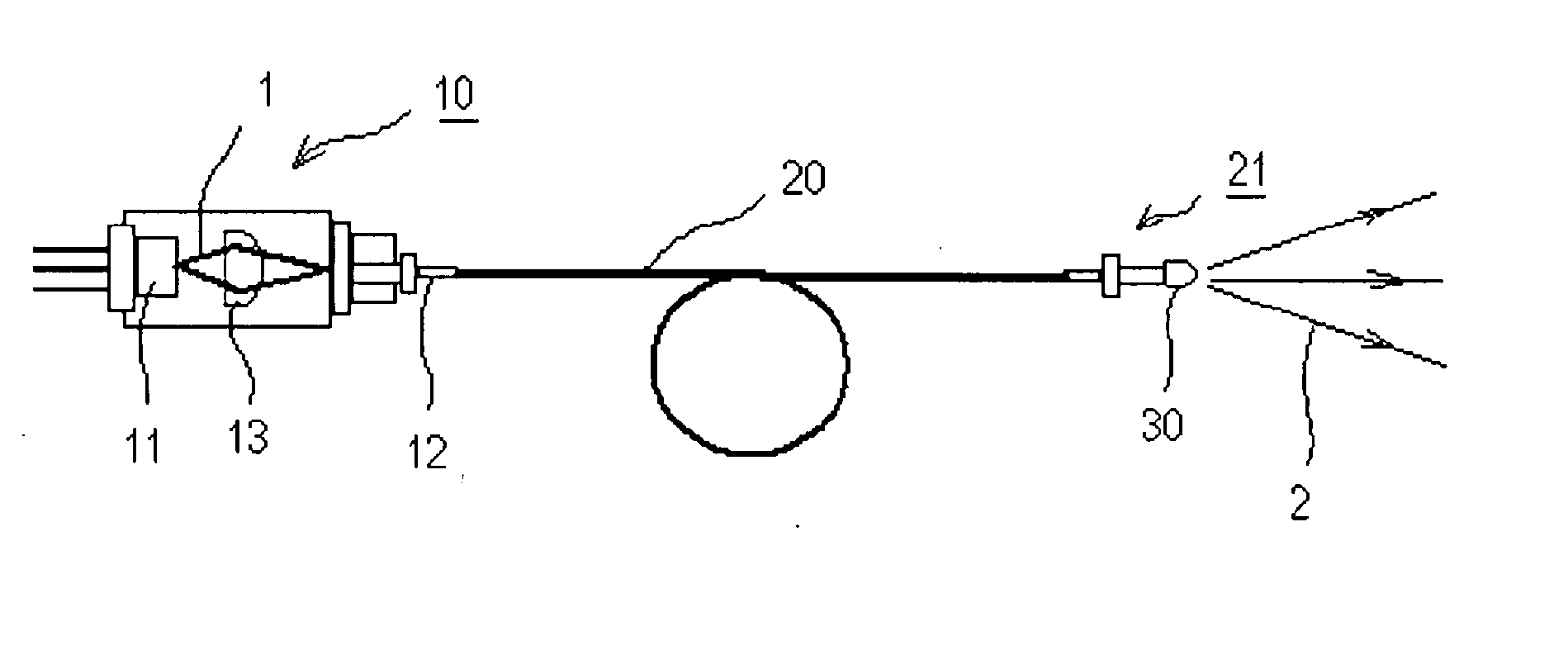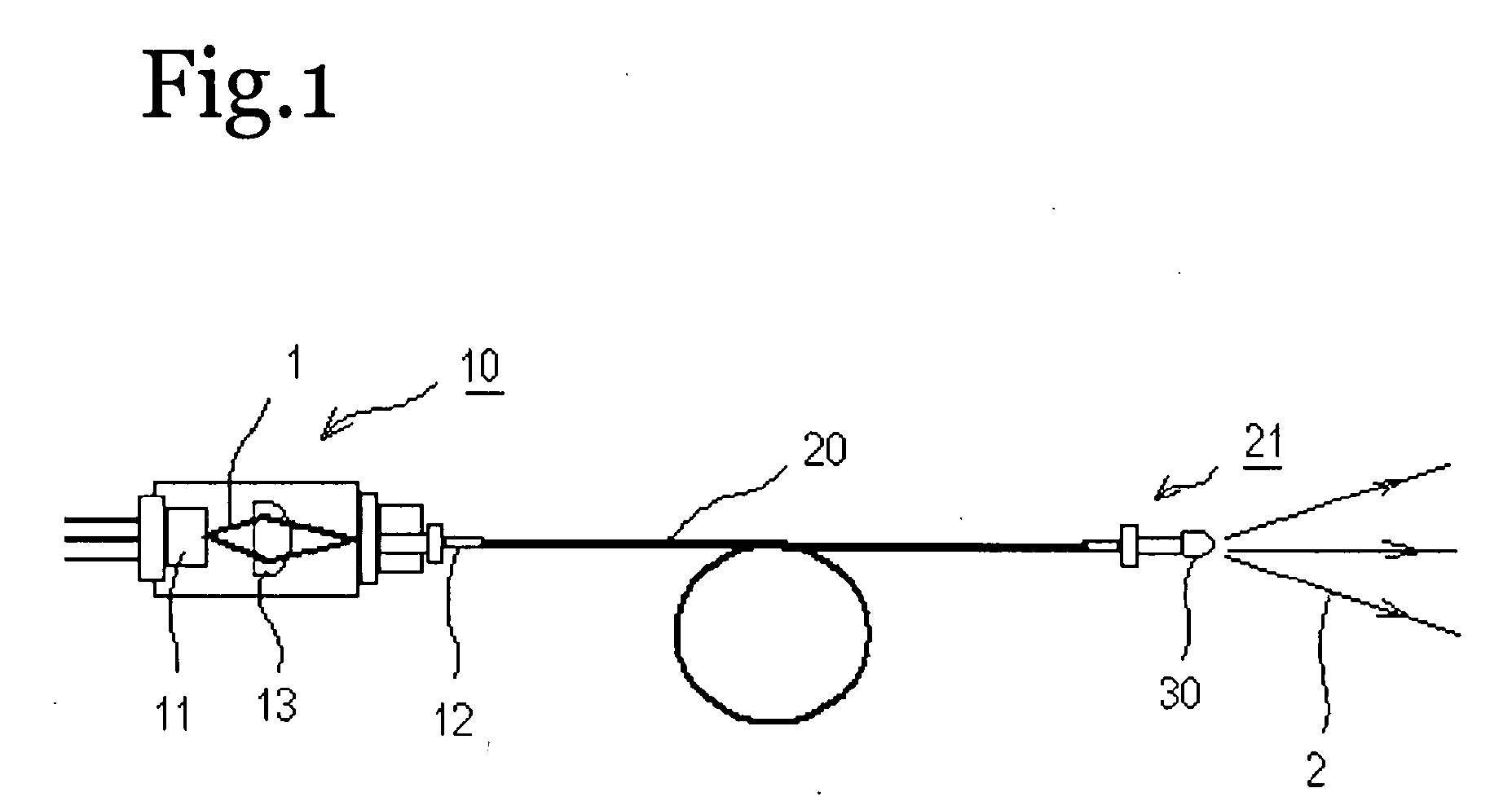Light Emitting Device
a technology of light-emitting devices and light-emitting tubes, which is applied in the direction of point-like light sources, vehicle headlamps, spectral modifiers, etc., can solve the problems of poor color reproducibility, difficult adjustment of control, and so as to achieve excellent color reproducibility, less variance in color tones, and wider divergence angle
- Summary
- Abstract
- Description
- Claims
- Application Information
AI Technical Summary
Benefits of technology
Problems solved by technology
Method used
Image
Examples
example 1
[0228] As shown in FIG. 1, this light emitting device comprised an excitation light source 10, a light guide 20, and a wavelength conversion member 30.
[0229] A light emitting element 11 which is a laser diode composed of a GaN-based semiconductor having an emission peak wavelength near 405 nm was used as the excitation light source 10. A lens 13 for converging excitation light 1 from the laser diode was disposed on the front face of this laser diode.
[0230] The light guide 20 was connected at one end to the emission portion 12 of the excitation light source 10, and connected at the other end to the output portion 21. The light guide 20 used here was an SI-type, made of quartz, with a core diameter of 114 μm and a cladding diameter of 125 μm.
[0231] The wavelength conversion member 30 was molded such that the fluorescent substance would be uniformly dispersed in the resin, and was attached to the output portion 21.
[0232] The fluorescent substance was a combination of Ca10(PO4)6Cl2:...
example 2
[0236] With this light emitting device, two types of fluorescent substance were used, CCA and YAG. Each fluorescent substance was uniformly mixed with a resin. The wavelength conversion member that was used had a three-layer structure in which YAG, CCA, and YAG were laminated in that order, starting from the side closest to the excitation light. The distal end of the light guide was supported by a light guide distal end member, and the wavelength conversion member was disposed so as to integrally cover both the light guide and the light guide distal end member, but other than the above, the structure was the same as that of the light emitting device in Example 1.
[0237] Each fluorescent substance and the resin were mixed in a ratio of 2:1, and the thickness of each layer was about 100 μm.
[0238] Using this structure allowed the desired white light to be obtained, and a light emitting device with high emission efficiency was obtained by combining with a light emitting element having ...
example 3
[0242] As shown in FIG. 1, this light emitting device comprised a excitation light source 10, a light guide 20, and a wavelength conversion member 30. The excitation light source 10 and the light guide 20 were the same as in Example 1. The wavelength conversion member 30 comprised a fluorescent substance 31 of BaMg2Al16O27:Eu,Mn in silicone resin, mixed in a weight ratio of 1:1, kneaded until uniform, and molded.
[0243] With a light emitting device with this structure, the excitation light 1 emitted from the laser diode was transmitted through the lens 13 and converged at the emission portion 12. The converged excitation light 1 was transmitted through the light guide 20 to the output portion 21. The excitation light 1 guided out of the output portion 21 was directed at the fluorescent substance of the wavelength conversion member 30 and its wavelength was converted, so that light 2 having the emission spectrum shown in FIG. 7 was obtained.
[0244] This light was emitted as green lig...
PUM
 Login to View More
Login to View More Abstract
Description
Claims
Application Information
 Login to View More
Login to View More - R&D
- Intellectual Property
- Life Sciences
- Materials
- Tech Scout
- Unparalleled Data Quality
- Higher Quality Content
- 60% Fewer Hallucinations
Browse by: Latest US Patents, China's latest patents, Technical Efficacy Thesaurus, Application Domain, Technology Topic, Popular Technical Reports.
© 2025 PatSnap. All rights reserved.Legal|Privacy policy|Modern Slavery Act Transparency Statement|Sitemap|About US| Contact US: help@patsnap.com



